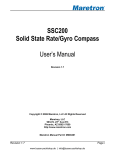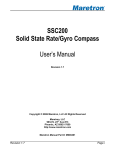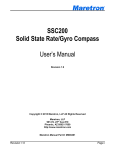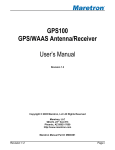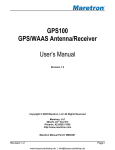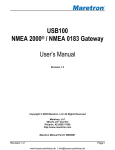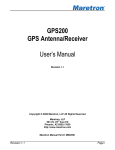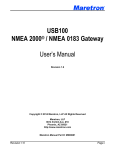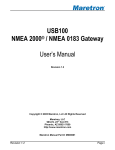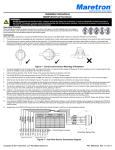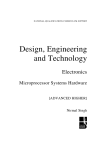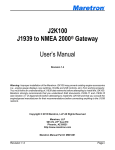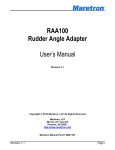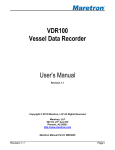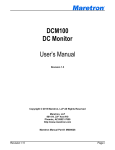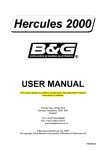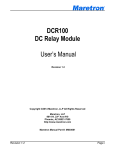Download SSC300 Solid State Rate/Gyro Compass User's Manual
Transcript
SSC300 Solid State Rate/Gyro Compass User’s Manual Revision 1.0 Copyright © 2015 Maretron, LLP All Rights Reserved Maretron, LLP 9014 N. 23rd Ave #10 Phoenix, AZ 85021-7850 http://www.maretron.com Maretron Manual Part #: M003069 Revision 1.0 Page i SSC300 User’s Manual Revision History Revision 1.0 Original document. Page ii Description Revision 1.0 Table of Contents 1 2 3 4 5 6 7 8 9 10 11 General ..............................................................................................................................1 1.1 Introduction................................................................................................................1 1.2 Firmware Revision .....................................................................................................1 1.3 Features ....................................................................................................................1 1.4 SSC300 Accessories .................................................................................................2 1.5 Quick Install ...............................................................................................................2 Installation ..........................................................................................................................2 2.1 Unpacking the Box ....................................................................................................2 2.2 Choosing a Mounting Location ..................................................................................2 2.3 Mounting the SSC300 ...............................................................................................3 2.3.1 Mounting the SSC300 to a Horizontal Surface ...........................................3 2.3.2 Mounting the SSC300 to a Vertical Surface ...............................................4 2.4 Connecting the SSC300 ............................................................................................6 2.4.1 Connecting to NMEA 2000® Interface ........................................................6 2.4.2 Connecting to NMEA 0183 Interface ..........................................................8 2.4.3 Connecting Both NMEA 2000® and NMEA 0183 Interfaces ..................... 10 2.4.4 Checking Connections.............................................................................. 10 Calibration ........................................................................................................................ 10 3.1 Rate of Turn Zero Offset Calibration........................................................................ 10 3.2 Installation-Offset Correction (First Time) ................................................................ 10 3.2.1 Maretron Display Product Offset Correction ............................................. 11 3.2.2 Manual Installation-Offset Correction ....................................................... 11 3.3 Magnetic Deviation Calibration ................................................................................ 11 3.3.1 Maretron Display Initiated Deviation Calibration ....................................... 12 3.3.2 Automatic Power-Up Deviation Calibration............................................... 13 3.4 Installation-Offset Correction (Second Time) ........................................................... 13 Variation ........................................................................................................................... 13 4.1 Variation Input via NMEA 0183 Interface................................................................. 14 4.2 Variation Input via the NMEA 2000® Interface ......................................................... 14 4.3 Variation Input via Manual Entry .............................................................................. 15 4.4 Variation Source Selection ...................................................................................... 15 4.4.1 Variation Source Selection via Maretron Display ...................................... 16 4.4.2 Variation Source Selection via NMEA 0183 Interface............................... 16 Rate of Turn ..................................................................................................................... 16 5.1 Rate of Turn Damping Period Selection with Maretron Display ............................... 16 5.2 Rate of Turn Damping Period Selection by NMEA 0183 Interface .......................... 16 5.3 Rate of Turn Zeroing ............................................................................................... 16 Maintenance .................................................................................................................... 17 Troubleshooting ............................................................................................................... 18 Technical Specifications................................................................................................... 19 Technical Support ............................................................................................................ 21 Installation Template ........................................................................................................ 22 Maretron (2 Year) Limited Warranty ................................................................................. 23 Revision 1.0 Page iii SSC300 User’s Manual Table of Figures Figure 1 – Mounting the SSC300 to a Horizontal Surface ......................................................... 4 Figure 2 – Mounting the SSC300 to Vertical Surface ................................................................ 5 Figure 3 – NMEA 2000® / NMEA 0183 Interface Connector Locations ..................................... 6 Figure 4 – NMEA 2000®/Power Connector Face Views ............................................................ 7 Figure 5 – SSC300 with NMEA 2000® Connection Only ........................................................... 7 Figure 6 – NMEA 0183 Connector Face Views ......................................................................... 8 Figure 7 – NMEA 0183 Cable/Wire Color Coding ...................................................................... 8 Figure 8 – SSC300 with NMEA 0183 Connection Only ............................................................. 9 Figure 9 – Troubleshooting Guide ........................................................................................... 18 Figure 10 – Horizontal Mounting Surface Template ................................................................ 22 Figure 11 – Vertical Mounting Surface Template ..................................................................... 22 Table of Appendices Appendix A – NMEA 0183 Interfacing ..................................................................................... A1 Appendix B – NMEA 2000® Interfacing.................................................................................... B1 Appendix C – Connecting to a PC Via NMEA 0183 ................................................................. C1 Appendix D – Configuring the SSC300 to Transmit True Heading Data ................................. D1 Appendix E – Configuring the SSC300 to Transmit the HDT Sentence for …and Radars ...... E1 Page iv Revision 1.0 1 General 1.1 Introduction Congratulations on your purchase of the Maretron SSC300 Solid State Rate/Gyro Compass. Maretron has designed and built your compass to the highest standards for years of reliable, dependable, and accurate service. Maretron’s SSC300, implementing the second generation of Maretron's award-winning solid state compass technology, is a solid state, rate gyro electronic compass that provides better than 0.7° heading accuracy through ±45° of roll and pitch angle, and better than 1° roll and pitch accuracy in static conditions. Each SSC300 is factory calibrated for maximum accuracy. It delivers precise, reliable heading and rate of turn information ten times per second, and vessel attitude including pitch and roll readings once per second.. A micromachined 3-axis rate gyro is used in conjunction with the 3-axis accelerometer by advanced stabilization algorithms to provide accurate, stable readings during dynamically changing conditions such as hard turns or rough seas, making it an ideal heading sensor for autopilot or radar overlay applications. Maretron’s SSC300 is certified to the NMEA 2000® network standard and compatible with the NMEA 0183 digital interface standard. It connects directly with any NMEA 2000® network, and, with the optional NMEA 0183 cable accessory, with NMEA 0183 listeners to share information with navigational software, chart plotters, autopilots, and dedicated instrument displays – including Maretron’s graphical displays and N2KView® software. The SSC300 can be automatically calibrated for deviation. Its dynamic accuracy is improved with advanced digital filtering of the 3-axis magnetometer, 3-axis accelerometer and 3-axis rate gyro. The SSC300 is engineered and manufactured to the highest standards (IEC 60945 Maritime Navigation and Radiocommunication Equipment). Its compact waterproof housing will provide years of reliable performance. The Maretron SSC300 is designed to operate within the harsh demands of the marine environment. However, no piece of marine electronic equipment can function properly unless installed, calibrated, and maintained in the correct manner. Please read carefully and follow these instructions for installation, calibration, and usage of the Maretron SSC300 in order to ensure optimal performance. 1.2 Firmware Revision This manual corresponds to SSC300 firmware revision 1.0. 1.3 Features The Maretron SSC300 Solid State Compass has the following features. Better than 0.7° heading accuracy in status conditions Better than 1.5° heading accuracy in dynamic conditions Better than 1°/second rate of turn accuracy Revision 1.0 Page 1 SSC300 User’s Manual Better than 1° pitch/roll accuracy Three-axis magnetometer, Three-axis rate gyro, and Three-axis accelerometer Outputs NMEA 0183 and NMEA 2000 data simultaneously (optional NMEA 0183 cable accessory required for NMEA 0183 output) IP67 waterproof enclosure 1.4 SSC300 Accessories Maretron offers the following accessories for the SSC300: FA-CF-ST Micro/Mid Field Attachable Connector (Straight Female) MARE-004-1M-7 SSC200/SSC300 Compass NMEA 0183 10 meter connection cable 1.5 Quick Install Installing the Maretron SSC300 compass involves the following six steps. Please refer to the individual sections for additional details. 1. 2. 3. 4. 5. 6. 7. Unpack the Box (Section 2.1) Choose a Mounting Location (Section 2.2) Mount the SSC300 Compass (Section 2.3) Connect the SSC300 Compass (Section 2.4) Calibrate the SSC300 Compass for Magnetic Deviation (Section 3.2) Calibrate the SSC300 Compass for Installation-Offset (Section 3.4) Use Default Variation Source or Select an Appropriate Variation Source (Section 4) 2 Installation 2.1 Unpacking the Box When unpacking the box containing the Maretron SSC300, you should find the following items. 1 - SSC300 Solid State Compass 2 - Mounting Brackets 4 - Mounting Bracket Screws 4 - Mounting Screws 1 - SSC300 User’s Manual 1 - Warranty Registration Card If any of these items are missing or damaged, please contact Maretron. 2.2 Choosing a Mounting Location The selection of a suitable mounting location is important for the optimal performance of the Maretron SSC300. The mounting location and orientation of the Maretron SSC300 should be: Page 2 Revision 1.0 1. Level with the Earth’s Horizontal Plane – Although the SSC300 can be calibrated in the vessel to compensate for pitch and roll installation-offset, it is best to mount the compass as level as possible to maximize its pitch and roll operational range. 2. Oriented with Arrow Pointing to Bow Parallel to Vessel Centerline – Although the SSC300 can be calibrated in the vessel to compensate for heading installation-offset, it is best to mount the compass pointed towards the bow and parallel to the vessel centerline. The SSC300 can be mounted in other orientations, although this requires additional configuration steps; please refer to Section 2.3 on page 3 for details. 3. Near the Center of Gravity (CG) of the Vessel – The compass experiences the least amount of movement when located at the CG, which allows the most accurate readings. This is similar to a traditional card/needle compass, where the farther the compass is from the CG, then the more the fluid sloshes around, making accurate readings more difficult. 4. Away from Structures Containing Ferrous Metals – The earth’s lines of magnetic flux tend to become distorted in the vicinity of ferrous metals, which can potentially cause errors in the compass’s indicated heading. The SSC300 can be calibrated to compensate for these errors, but it is still best to minimize the errors by placing the compass as far away from ferrous metals as is practical. 5. Away from Magnetic Field Sources – Power or ignition cables, electric motors, and other electronic equipment can create magnetic fields. The earth’s lines of magnetic flux tend to become distorted in the vicinity of magnetic field sources, which can potentially cause errors in the compass’s indicated heading. The magnetic fields tend to come and go as power is switched on and off, which makes compensation impractical. Therefore, you should try to mount the compass as far away as possible from these magnetic field sources (doubling the distance between the magnetic field source and the compass will reduce the field strength by a factor of approximately 8). Also, always observe any “compass-safe distance” markings on other electronic equipment. 6. Minimal Vibration – Although the SSC300 is more tolerant of vibration than a fluxgate compass, it is best to mount the compass in a location free of vibration as opposed to a location with vibration. 7. Limited Water Exposure – The SSC300 has an IP67 rating which means the compass is able to withstand nozzle spray and is protected against water immersion up to 1m for up to 30 minutes. Please avoid areas which would result in the SSC300 being immersed in water which exceeds these depths or times. 2.3 Mounting the SSC300 The Maretron SSC300 compass can be mounted to a horizontal surface such as a floor or deck (Section 2.3.1) or it can be mounted to a vertical surface such as a wall or bulkhead (Section 2.3.2). 2.3.1 Mounting the SSC300 to a Horizontal Surface Mounting the SSC300 compass to a horizontal surface requires that the provided mounting brackets be fastened to the bottom of the SSC300 using the provided brass flat head screws. Once the mounting brackets are securely fastened to the bottom of the SSC300, attach the SSC300 securely to the vessel using the included brass mounting screws or other non-ferrous Revision 1.0 Page 3 SSC300 User’s Manual fasteners as shown in Figure 1. Do not use threadlocking compounds containing methacrylate ester, such as Loctite Red (271), as they will cause stress cracking of the plastic enclosure. The usual way of mounting the SSC300 to a horizontal surface is to mount it to the top of the horizontal surface; however, the SSC300 may be mounted upside down to the underside of a horizontal surface, provided that the SSC300 is programmed to recognize that it is mounted upside down. This can be done using a Maretron DSM150 display, DSM250 display, or Maretron N2KAnalyzer software (please refer to the appropriate user’s manual for details), or through a command sent to the SSC300 via the NMEA 0183 interface (please refer to Appendix A for details). Figure 1 – Mounting the SSC300 to a Horizontal Surface 2.3.2 Mounting the SSC300 to a Vertical Surface Mounting the SSC300 compass to a vertical surface requires that the provided mounting brackets be fastened to the side of the SSC300 using the provided brass flat head screws. Once the mounting brackets are securely fastened to the side of the SSC300, attach the SSC300 securely to the vessel using the included brass mounting screws or other non-ferrous fasteners Page 4 Revision 1.0 as shown in Figure 2. Do not use threadlocking compounds containing methacrylate ester, such as Loctite Red (271), as they will cause stress cracking of the plastic enclosure. The use of adhesives, Velcro, straps, or any mounting hardware not supplied with the SSC300 is not recommended, as it may adversely affect the performance of the SSC300. The usual way of mounting the SSC300 to a vertical surface is attaching the SSC300 to the forward side of a vertical surface, so that the side of the compass with the connectors is facing the bow of the boat; however, the SSC300 may be mounted to the astern side of a vertical surface, so that the side of the compass with the connectors is facing the stern of the boat, provided that the SSC300 is programmed to recognize that it is mounted in this way (“backwards”). This can be done using a Maretron DSM150 display, DSM250 display, or Maretron N2KAnalyzer software (please refer to the appropriate user’s manual for details), or through a command sent to the SSC300 via the NMEA 0183 interface (please refer to Appendix A for details). Figure 2 – Mounting the SSC300 to Vertical Surface Revision 1.0 Page 5 SSC300 User’s Manual 2.4 Connecting the SSC300 You have a choice of connecting the SSC300 to a NMEA 2000® interface (Section 2.4.1), NMEA 0183 interface (Section 2.4.2), or connecting both interfaces simultaneously (Section 2.4.2.2). The SSC300 has two connection ports. Please use the M000102 Micro Cap which is shipped installed on the NMEA 0183 connector to cover unused connectors. NMEA 2000 / Power Connector NMEA 0183 Connector Figure 3 – NMEA 2000® / NMEA 0183 Interface Connector Locations 2.4.1 Connecting to NMEA 2000® Interface The Maretron SSC300 provides a connection to an NMEA 2000® interface through a five pin male connector (Figure 4). You connect the SSC300 to an NMEA 2000® network using a Maretron NMEA 2000® cable (or compatible cable) by connecting the female end of the cable to the SSC300 (note the key on the male connector and keyway on the female connector) as shown in Figure 5 below.. Be sure the cable is connected securely and that the collar on the cable connector is tightened firmly. Connect the other end of the cable (male) to the NMEA 2000 ® network in the same manner. The SSC300 is designed such that you can plug or unplug it from an NMEA 2000® network while the power to the network is connected or disconnected. Please follow recommended practices for installing NMEA 2000® network products. Page 6 Revision 1.0 Figure 4 – NMEA 2000®/Power Connector Face Views Figure 5 – SSC300 with NMEA 2000® Connection Only Revision 1.0 Page 7 SSC300 User’s Manual 2.4.2 Connecting to NMEA 0183 Interface The Maretron SSC300 provides a connection to an NMEA 0183 interface through an eight pin male connector (Figure 6). You connect the SSC300 to an NMEA 0183 network using the optional MARE-004-1M-7 Maretron 10 meter cable by connecting the female end of the cable to the SSC300 (note the key on the male connector and keyway on the female connector). Be sure the cable is connected securely and that the collar on the cable connector is tightened firmly. Figure 6 – NMEA 0183 Connector Face Views Connect the other end of the cable consisting of individual wires using recommended practices for installing NMEA 0183 products. Please note that NMEA 0183 does not have a standard for connectors and the customer/installer should contact the manufacturer of the equipment to which the SSC300 is being connected for information on how to properly connect the device to the SSC300. The individual wires found within the cable have the following color coding. Wire Color Gray Brown Blue White Name TXA TXB RXA RXB Description Transmit Differential Output A Signal Transmit Differential Output B Signal Receive Differential Input A Signal Receive Differential Input B Signal Figure 7 – NMEA 0183 Cable/Wire Color Coding 2.4.2.1 Power Connections If the NMEA 2000® interface is connected, power is supplied to the SSC300 through the NMEA 2000® network connection. If only the NMEA 0183 interface is used, power connections must be made via the NMEA 2000®/Power connector. Using the optional FA-CF-ST Micro Field Attachable Connector (Female), connect a cable containing two power wires (not included) to pins 2 and 3 of the field attachable connector (only the two power pins need be connected) as shown in Figure 4 on Page 8 Revision 1.0 page 7, assemble the connector per the instructions packaged with the connector, and screw the connector snugly into the NMEA 2000®/Power connector on the SSC300, as shown in Figure 8 below. Please ensure that the cable has at least a 6mm diameter to ensure a watertight seal to the Field Attachable Connector. Figure 8 – SSC300 with NMEA 0183 Connection Only 2.4.2.2 Supported NMEA 0183 Baud Rates The SSC300 compass supports NMEA0183 communication at both 4800 baud and 38400 baud. All SSC300 Compasses are shipped with a baud rate of 4800 baud. The baud rate may be set to 38400 baud by connecting to the compass using a terminal emulator (See Appendix C for details) and sending the following strings to the compass through the NMEA 0183 connection: shell This will cause the “cmd>” command prompt to be displayed tm setbaud 38400 Revision 1.0 Page 9 SSC300 User’s Manual At this point, you must change the baud rate of your connection to 38400 baud to continue, as the SSC300 has now been set to the higher baud rate. tm storebaud This causes the new baud rate to be stored to non-volatile memory, so the compass will retain this baud rate when it is powered down. 2.4.3 Connecting Both NMEA 2000® and NMEA 0183 Interfaces The SSC300 can be simultaneously connected to both an NMEA 2000® network and an NMEA 0183 network. 2.4.4 Checking Connections Once the NMEA 2000®/Power and/or NMEA 0183 connections to the Maretron SSC300 have been completed, check to see that heading information is being properly transmitted by observing an appropriate display. Refer to Section 7, “Troubleshooting”, if no heading information appears, otherwise proceed to Section 3 entitled “Calibration”. 3 Calibration In order to provide accurate heading indication, the SSC300 must be calibrated in the vessel after installation. The three calibration procedures that must be carried out are rate of turn zero offset calibration (Section 3.1), magnetic deviation calibration (Section 3.2) and installation-offset correction (Section 3.4). These procedures should be carried out after the initial compass installation and again at any time that the magnetic environment of the vessel has changed significantly (for example, new cables have been routed near the compass or new equipment made of ferrous metal has been installed near the compass). WARNING: It is imperative that calibration procedures be carried out upon installation of the SSC300 to ensure accurate readings. 3.1 Rate of Turn Zero Offset Calibration Since the SSC300 uses the internal rate of turn gyros during the magnetic deviation calibration process, the rate of turn gyros need to zeroed first. It is possible to do “Rate of Turn Zeroing” using a Maretron display product, such as the DSM150, DSM250, or N2KAnalyzer software (please refer to the display product user’s manual for details). 3.2 Installation-Offset Correction (First Time) After installation and prior to magnetic deviation calibration, it is important to perform installationoffset correction so that the compass is aware of its exact orientation in the installation. The heading is also set during this process, but will be set once more after magnetic deviation calibration. Installation-offset correction is done using one of four possible procedures. 1. Maretron Display Product Initiated (Section 3.2.1) Page 10 Revision 1.0 2. Manual Installation-Offset Correction (Section 3.2.2) 3. Through the NMEA 0183 Interface (Appendix A) 4. Through the NMEA 2000® Interface (Appendix B) The preferred method for installation-offset is to use a Maretron display (procedure 1) which will automatically calibrate the SSC300 without physically adjusting the compass as describe under procedure 2 (). As an alternative to procedures 1 and 2, users with direct access to the NMEA 0183 and NMEA 2000® interfaces can perform installation-offset correction through the NMEA 0183 interface (see Appendix A) or the NMEA 2000® interface (see Appendix B). 3.2.1 Maretron Display Product Offset Correction Installation-offset correction can be performed using a Maretron display product (e.g., DSM150, DSM250, or N2KAnalyzer software). The procedure is as follows: 1. Make sure the vessel is laying in flat water on a known heading. 2. Use the display’s menu items to locate and send the compass installation-offset correction command (please refer to display product user’s manual). 3.2.2 Manual Installation-Offset Correction Manual installation-offset correction is performed by physically aligning the compass with the vessel. The procedure is as follows: 1. With the vessel laying flat in the water, adjust the roll angle of the SSC300 by adding small washers or spacers between the mounting bracket holes and mounting surface until the display reads zero for the roll angle (skip this step if you are not interested in viewing the vessel’s roll angle). 2. With the vessel laying flat in the water, adjust the pitch angle of the SSC300 by adding small washers or spacers between the mounting bracket holes and mounting surface until the display reads zero for the pitch angle (skip this step if you are not interested in viewing the vessel’s pitch angle). 3. With the vessel laying flat in the water on a known heading, adjust the heading of the SSC300 by rotating it until the display reads the known vessel heading. 4. Recheck that the roll and pitch readings are zero and that the indicated heading is correct (repeat steps 1 through 3 as necessary). 5. Securely fasten the SSC300 by tightening the mounting screws. 3.3 Magnetic Deviation Calibration Magnetic and/or ferrous items near a magnetic compass such as the SSC300 can cause errors in the compass’ heading output. These errors are referred to as magnetic deviation. The Maretron SSC300 compass can compensate for heading errors caused by magnetic deviation by learning about the magnetic environment in which it has been mounted. This is done using one of four possible magnetic deviation calibration procedures. 1. Maretron Display Product Initiated (Section 3.3.1) 2. Automatically at Power-Up (Section 3.3.2) Revision 1.0 Page 11 SSC300 User’s Manual 3. Through the NMEA 0183 Interface (Appendix A) 4. Through the NMEA 2000® Interface (Appendix B) All the procedures require that the vessel be turned in consecutive circles during which time the SSC300 uses changing heading information along with readings from the angular rate sensor to calculate hard and soft iron magnetic deviation. Upon a successful completion of deviation calibration, the SSC300 stores the deviation values in permanent memory for subsequent compensation. Under certain conditions (e.g., turning to fast or to slow), the SSC300 will not successfully complete the calibration process and the SSC300 will not store the deviation values in its permanent memory. Therefore, it is important to verify that the deviation calibration process completed successfully. The preferred method for deviation calibration is to use a Maretron display (procedure 1) because you receive direct feedback on the calibration process with a clear indication of a successful or unsuccessful deviation calibration. Deviation calibration done automatically at power-up (procedure 2) is less desirable than procedure 1 because it is more difficult to verify that a successful deviation calibration completed. As an alternative to procedures 1 and 2, users with direct access to the NMEA 0183 and NMEA 2000 ® interfaces can perform magnetic deviation calibration directly through the NMEA 0183 interface (see Appendix A) or the NMEA 2000® interface (see Appendix B). These direct access methods also provide an indication of a successful deviation calibration or an indication of an unsuccessful deviation calibration and the corresponding reason for the failure. 3.3.1 Maretron Display Initiated Deviation Calibration Maretron display initiated deviation calibration is accomplished by turning the vessel through consecutive circles while the SSC300 receives a command from a Maretron display product (e.g., DSM150, DSM250, or N2KAnalyzer software). The procedure is as follows: 1. Ensure that the compass has been properly installed per Section 2. 2. Warm up the compass by operating it for approximately 10 minutes. 3. Turn the vessel (either direction) such that you complete a full 360° turn in 2½ minutes or less (try not to go below 1 minute for a complete circle). 4. While continuing to turn the vessel as indicated in step 3, use the display’s menu items to locate and send the deviation calibration command (please refer to the display product user’s manual). 5. Continue turning the vessel through at least three complete circles until the display indicates a successful deviation calibration. While turning the vessel, try to maintain a circle by holding the rudder at a constant angle. In addition, try to minimize the vessel’s pitch and roll by calibrating on calm, flat water. After deviation calibration is complete, the results of the deviation calibration, which indicate the quality of the compass installation environment, may be seen using a Maretron display product (e.g., DSM150, DSM250, or N2KAnalyzer software). This allows you to compare different installation points on a vessel to determine the optimum location for the SSC300. Page 12 Revision 1.0 3.3.2 Automatic Power-Up Deviation Calibration Automatic power-up deviation calibration is accomplished by turning the vessel through four complete circles within 10 minutes of power-up. The procedure is as follows: 1. Ensure that the compass has been properly installed per Section 2. 2. Warm up the compass by operating it for approximately 10 minutes. 3. Turn the vessel (either direction) such that you complete a full 360° turn in 2½ minutes or less (try not to go below 1 minute for a complete circle). 4. While continuing to turn the vessel as indicated in step 3, remove the power from the compass and reapply power (this initiates deviation calibration). 5. Continue turning the vessel through four complete circles in less than 10 minutes from the time power was applied. 6. Successful deviation is indicated when the SSC300 outputs the following sequence: a) 0 Degrees for two seconds followed by b) 90 degrees for two seconds followed by c) 180 degrees for two seconds followed by d) 270 degrees for two seconds followed by the actual heading While turning the vessel, try to maintain a circle by holding the rudder at a constant angle. In addition, try to minimize the vessel’s pitch and roll by calibrating on calm, flat water. 3.4 Installation-Offset Correction (Second Time) After installation and successful magnetic deviation calibration, it is important to repeat installation-offset correction so that the displayed compass heading, pitch, and roll match the actual vessel heading, pitch, and roll. Please refer to Section 3.2 for details on how to perform the procedure. 4 Variation Variation is the angular difference between the true meridian (great circle connecting the geographic poles) and the magnetic meridian (direction of the lines of magnetic flux). Variation has different values at different locations on the earth with most areas undergoing change to the variation over time. Normally, heading information is displayed as either a “true” heading (a direction relative to the geographic poles) or it is displayed as a “magnetic” heading (a direction relative to the lines of magnetic flux). North-seeking gyrocompasses are capable of measuring direction relative to the geographic poles (“true”) whereas magnetic compasses measure direction relative to the earth’s local magnetic flux (“magnetic”). The SSC300 is a magnetic compass; therefore, it requires an external source for variation if you want to view your heading in “true” format. The SSC300 is capable of receiving variation in one of three ways; 1) via the NMEA 0183 interface, 2) via the NMEA 2000 ® interface, or 3) through manual variation entry. Revision 1.0 Page 13 SSC300 User’s Manual Normally, the SSC300 will automatically use variation from either the NMEA 0183 interface or the NMEA 2000® interface, however, you can force the SSC300 to use variation from only the NMEA 0183 interface or you can force the SSC300 to use variation from only the NMEA 2000® interface or you can force SSC300 to only use manually entered variation. WARNING: Multiple variation sources that are received by the SSC300 (i.e., NMEA 0183 and NMEA 2000® interfaces) will cause confusion as to the correct source to be used for true heading indications. If more than one variation source is available, then the SSC300 needs to be programmed to use the appropriate source for reporting subsequent true heading information. See Section 4.4 for details on choosing a specific variation source when more than one variation source is available. 4.1 Variation Input via NMEA 0183 Interface As shipped from the factory, the SSC300 automatically looks for variation data coming from the NMEA 0183 interface. The SSC300 accepts variation data from the Recommended Minimum Specific GNSS Data (RMC) sentence or the SSC300 computes variation from the Course Over Ground and Ground Speed (VTG) sentence. If the SSC300 does indeed receive variation information from the NMEA 0183 interface, then it will do the following: 1. Transmit the Heading, Deviation & Variation (HDG) sentence including the variation field as seen from the RMC or VTG sentence over the NMEA 0183 interface if HDG is enabled (see Appendix A for enabling or disabling NMEA 0183 sentences). 2. Transmit the Heading True (HDT) sentence using variation data from the RMC or VTG sentence over the NMEA 0183 interface if HDT is enabled (see Appendix A for enabling or disabling NMEA 0183 sentences). 3. Transmit over the NMEA 2000® interface the Magnetic Variation PGN (127258) with the Variation Source field value corresponding to the received NMEA 0183 variation data from the RMC or VTG sentence. The PGN’s Variation Source field will be transmitted with the lowest possible quality indicator, which is “Manual Entry”. 4.2 Variation Input via the NMEA 2000® Interface As shipped from the factory, the SSC300 automatically looks for variation data coming from the NMEA 2000® interface. The SSC300 accepts variation data from the Magnetic Variation PGN (127258). If the SSC300 does indeed receive variation information from the NMEA 2000® interface, then it will do the following: 1. Transmit the Heading, Deviation & Variation (HDG) sentence including the variation field as seen from the Magnetic Variation PGN (127258) from the NMEA 2000 interface if HDG is enabled (see Appendix A for enabling or disabling NMEA 0183 sentences). 2. Transmit the Heading True (HDT) sentence using variation data from the Magnetic Variation PGN (127258) from the NMEA 2000 interface if HDT is enabled (see Appendix A for enabling or disabling NMEA 0183 sentences). Some NMEA 2000® networks may have multiple nodes transmitting the 127258 Magnetic Variation PGN, which can cause problems with true heading output on the NMEA 0183 interface if any of the nodes are transmitting incorrect magnetic variation values. If you notice heading Page 14 Revision 1.0 readings different from what you expect, you can use tools such as N2KAanalyzer® to locate all sources of the 127258 Magnetic Variation PGN. 4.3 Variation Input via Manual Entry If no other source of variation is available (i.e., from either the NMEA 0183 or NMEA 2000 ® interface), the SSC300 can be programmed with a fixed variation value for a given location (this value can be found on most navigational charts). If variation is manually entered into the SSC300, then it will do the following: 1. Transmit the Heading, Deviation & Variation (HDG) sentence including the variation field as manually entered over the NMEA 0183 interface if HDG is enabled (see Appendix A for enabling or disabling NMEA 0183 sentences). 2. Transmit the Heading True (HDT) sentence using variation data as manually entered over the NMEA 0183 interface if HDT is enabled (see Appendix A for enabling or disabling NMEA 0183 sentences). 3. Transmit over the NMEA 2000® interface the Magnetic Variation PGN (127258) with the Variation Source field value corresponding to the manually entered variation. The PGN’s Variation Source field will be transmitted with the lowest possible quality indicator, which is “Manual Entry”. WARNING: Magnetic variation changes as your position on the earth changes; therefore, the variation should be adjusted with changes in position. The SSC300 will not automatically adjust variation with changes in position; it is the responsibility of the user to adjust variation with changes in position. 4.4 Variation Source Selection As shipped from the factory, the SSC300 automatically looks for variation from both the NMEA 0183 and NMEA 2000® interfaces. If there is only a single source of variation available (either from the NMEA 0183 or the NMEA 2000® interface), then there is no need to manually select a variation source. However, if there are multiple variation sources (i.e., variation available from both the NMEA 0183 and NMEA 2000® interfaces) or there is no source for variation (i.e., variation is not available from either the NMEA 0183 or the NMEA 2000 ® interfaces), then it is necessary to select a particular variation source. The SSC300 can be programmed to specifically use one of three possible variation sources: 1. Variation from Only NMEA 0183 Interface 2. Variation from Only NMEA 2000® Interface 3. Variation from Only Manual Entry The SSC300 can be programmed to accept a specific source for the variation data using one of two possible procedures. 1. Using a Maretron Display (Section 4.4.1) 2. Through the NMEA 0183 Interface (Section 4.4.2) Revision 1.0 Page 15 SSC300 User’s Manual 4.4.1 Variation Source Selection via Maretron Display You can program the SSC300 to use a particular variation source using a Maretron display product (e.g., DSM150, DSM250, or N2KAnalyzer software). Refer to the display product user’s manual for details on programming the SSC300 to use a specific variation source. 4.4.2 Variation Source Selection via NMEA 0183 Interface You can program the SSC300 to use a particular variation source through the NMEA 0183 interface. Refer to Appendix A for details on programming the SSC300 to use a specific variation source. 5 Rate of Turn The SSC300 is capable of measuring a vessel’s rate of turn and outputting the information over both the NMEA 0183 and NMEA 2000® interfaces. Furthermore, the SSC300 has a programmable damping period where the filter time can be increased for very slow turning vessels such as tugs pushing barges. Also, the SSC300 rate of turn indication may be zeroed to correct for any temperature-induced offset. The SSC300 can be programmed with different damping periods and have the rate of turn indication zeroed using one of two possible procedures. 1. Using a Maretron Display (Section 5.1) 2. Through the NMEA 0183 Interface (Section 5.2) 5.1 Rate of Turn Damping Period Selection with Maretron Display You can program the SSC300 to use a particular rate of turn damping period using a Maretron display product (e.g., DSM150, DSM250, or N2KAnalyzer software) . Refer to the display product user’s manual for details on programming the SSC300 to use a specific damping period. 5.2 Rate of Turn Damping Period Selection by NMEA 0183 Interface You can program the SSC300 to use a particular rate of turn damping period through the NMEA 0183 interface. Refer to Appendix A for details on programming the SSC300 to use a specific damping period. 5.3 Rate of Turn Zeroing The SSC300 may be used as a rate of turn indicator, which should read zero when the vessel is not turning. It is possible that the rate of turn indication has an offset; that is, it may show a non-zero value when the vessel is at rest. This offset changes with temperature but the SSC300 has the ability to remember the offset at different temperatures. You teach the SSC300 by using “Rate of Turn Zeroing”. It is possible to do “Rate of Turn Zeroing” using a Maretron display product, such as the DSM150, DSM250, or N2KAnalyzer software (please refer to the display product user’s manual for details). Page 16 Revision 1.0 6 Maintenance Regular maintenance is important to ensure continued proper operation of the Maretron SSC300. Perform the following tasks periodically: Clean the unit with a soft cloth. Do not use chemical cleaners as they may remove markings or may corrode the compass enclosure or seals. Do not use any cleaners containing acetone, as they will deteriorate the plastic enclosure. Ensure that the unit is mounted securely and cannot be moved relative to the mounting surface. If the unit is loose, tighten the mounting screws and repeat the magnetic deviation calibration and installation-offset correction. Check the security of the cables connected to the NMEA 2000® and/or NMEA 0183 interfaces and tighten if necessary. Revision 1.0 Page 17 SSC300 User’s Manual 7 Troubleshooting If you notice unexpected operation of the Maretron SSC300, follow the troubleshooting procedures in this section to remedy simple problems. Symptom No heading output Troubleshooting Procedure Check the connections to the NMEA 2000®/Power connector and/or NMEA 0183 Connector and tighten if necessary Ensure that power is supplied to the connected NMEA 2000® or NMEA 0183 cable For NMEA 0183 connections, ensure that the SSC300 is programmed to transmit the appropriate type of sentence (HDT, HDG, or HDM) required by the connected equipment. Inaccurate heading output If the HDT sentence is being transmitted, ensure that the SSC300 is provided with a source of magnetic variation information so that it can calculate true heading from the magnetic heading. Ensure the SSC300 is still mounted securely Ensure the SSC300 is still in a clean magnetic environment and that no power or ignition cables or magnetic or ferrous objects have been moved near the SSC300 Repeat the magnetic deviation compensation and installation-offset correction procedures Figure 9 – Troubleshooting Guide If these steps do not solve your problem, please contact Maretron Technical Support (refer to Section 9 for contact information). Warning: There are no user-serviceable components inside the Maretron SSC300. Opening the SSC300 will expose the sensitive electronic components to movement and adverse environmental conditions that may render the compass inoperative. Please do not open the SSC300, as this will automatically void the warranty. If service is required, please return the unit to an authorized Maretron service location. Page 18 Revision 1.0 8 Technical Specifications Specifications Parameter Static Heading Accuracy Dynamic Heading Accuracy Heading Display Resolution Settling Time Heading Update Rate Heading Deviation Alignment Calibration Pitch and Roll Range Pitch and Roll Accuracy Pitch and Roll Display Resolution Pitch and Roll Update Rate Pitch and Roll to Boat Alignment Rate of Turn Range Rate of Turn Accuracy Rate of Turn Update Rate NMEA 0183 Standard Value <0.7° RMS <1.5° RMS 0.1° 1 Second 10 per Second Yes Yes ±80° ±1° 0.1° 1 per Second Yes 0° - 250°/ Second ±1° per Second 10 per Second Compatible Comment ±45° Pitch and Roll - 15°C to 35°C With Maretron Display To Static Accuracy after 35°/Second Turn Adjustable up to 40 per Second Automatic In Boat Calibration with Maretron Displays With Maretron Display ±45° Pitch and Roll - 15°C to 35°C With Maretron Display Adjustable up to 40 per Second In Boat Calibration with Maretron Displays At 0° Pitch and Roll 0° Pitch and Roll - 15°C to 35°C Adjustable up to 40 per Second Up to 38,400 Baud (40 Hz Update Rate) Certifications Parameter NMEA 2000® Standard Maritime Navigation and Radiocommunication Equipment & Systems Maritime Navigation and Radiocommunication Equipment & Systems FCC and CE Mark Comment Level A IEC 61162-3 Tested to IEC 60945 Electromagnetic Compatibility NMEA 2000® Parameter Group Numbers (PGNs) - See Appendix B for Details Description Periodic Data PGNs Response to Requested PGNs Protocol PGNs Maretron Proprietary PGNs Revision 1.0 PGN # 127250 127257 127251 126464 126996 126998 059392 059904 060416 060160 060928 065240 126208 126720 PGN Name Vessel Heading Attitude Rate of Turn PGN List (Transmit and Receive) Product Information Configuration Information ISO Acknowledge ISO Request ISO Transport Protocol, Connection Management ISO Transport Protocol, Data Transfer ISO Address Claim ISO Address Command NMEA Request/Command/Acknowledge Configuration Default Rate 10 Times/Second 1 Time/Second 10 Times/Second N/A N/A N/A N/A N/A N/A N/A N/A N/A N/A N/A Page 19 SSC300 User’s Manual NMEA 0183 Sentences - See Appendix A for Details Description Acronym Transmitted HDG Sentences HDM HDT ROT PMAROUT TXT Received RMC Sentences VTG Sentence Name Heading, Deviation, and Variation Heading, Magnetic Heading, True Rate of Turn Maretron Proprietary Attitude (Pitch and Roll) Text Transmission Recommended Minimum Specific GNSS Data Course Over Ground and Ground Speed Default Rate 10 Times/Second N/A N/A 5 Times/Second 1 Time/Second N/A N/A N/A Electrical Parameter Operating Voltage Power Consumption Load Equivalence Number (LEN) Reverse Battery Protection Load Dump Protection Value 9 to 32 Volts <50mA 1 Yes Yes Comment DC Voltage Average Current Drain NMEA 2000® Spec. (1LEN = 50 mA) Indefinitely Energy Rated per SAE J1113 Mechanical Parameter Size Weight Mounting Value 4.46” x 3.23” x 2.14” (113mm x 82mm x 54 mm) 7 oz. (198 g) Deck or Bulkhead Comment Including Mounting Flanges Including Mounting Bracket Environmental Parameter IEC 60945 Classification Degree of Protection Operating Temperature Storage Temperature Relative Humidity Vibration Rain and Spray Solar Radiation Corrosion (Salt Mist) Electromagnetic Emission Electromagnetic Immunity Safety Precautions Page 20 Value Exposed IP67 -25°C to 55°C -40°C to 85°C 93%RH @40° per IEC60945-8.2 2-13.2Hz @ ±1mm, 13.2-100Hz @ 7m/s2 per IEC 60945-8.7 12.5mm Nozzle @ 100liters/min from 3m for 30min per IEC 60945-8.8 Ultraviolet B, A, Visible, and Infrared per IEC 60945-8.10 4 times 7days @ 40°C, 95%RH after 2 hour Salt Spray Per IEC 60945-8.12 Conducted and Radiated Emission per IEC 60945-9 Conducted, Radiated, Supply, and ESD per IEC 60945-10 Dangerous Voltage, Electromagnetic Radio Frequency per IEC 60945-12 Revision 1.0 9 Technical Support If you require technical support for Maretron products, you can reach us in one of the following ways: Telephone: 1-866-550-9100 Fax: 1-602-861-1777 E-mail: [email protected] World Wide Web: http://www.maretron.com Mail: Maretron, LLP Attn: Technical Support 9014 N. 23rd Ave Suite 10 Phoenix, AZ 85021 USA Revision 1.0 Page 21 SSC300 User’s Manual 10 Installation Template Please check the dimensions before using the following diagrams as templates for drilling the mounting holes because the printing process may have distorted the dimensions. 3.87” 1.42” Figure 10 – Horizontal Mounting Surface Template 2.75” Figure 11 – Vertical Mounting Surface Template Page 22 Revision 1.0 11 Maretron (2 Year) Limited Warranty Maretron warrants the SSC300 to be free from defects in materials and workmanship for two (2) years from the date of original purchase. If within the applicable period any such products shall be proved to Maretron’s satisfaction to fail to meet the above limited warranty, such products shall be repaired or replaced at Maretron’s option. Purchaser's exclusive remedy and Maretron’s sole obligation hereunder, provided product is returned pursuant to the return requirements below, shall be limited to the repair or replacement, at Maretron’s option, of any product not meeting the above limited warranty and which is returned to Maretron; or if Maretron is unable to deliver a replacement that is free from defects in materials or workmanship, Purchaser’s payment for such product will be refunded. Maretron assumes no liability whatsoever for expenses of removing any defective product or part or for installing the repaired product or part or a replacement therefore or for any loss or damage to equipment in connection with which Maretron’s products or parts shall be used. With respect to products not manufactured by Maretron, Maretron’s warranty obligation shall in all respects conform to and be limited to the warranty actually extended to Maretron by its supplier. The foregoing warranties shall not apply with respect to products subjected to negligence, misuse, misapplication, accident, damages by circumstances beyond Maretron’s control, to improper installation, operation, maintenance, or storage, or to other than normal use or service. THE FOREGOING WARRANTIES ARE EXPRESSLY IN LIEU OF AND EXCLUDES ALL OTHER EXPRESS OR IMPLIED WARRANTIES, INCLUDING BUT NOT LIMITED TO THE IMPLIED WARRANTIES OF MERCHANTABILITY AND OF FITNESS FOR A PARTICULAR PURPOSE. Statements made by any person, including representatives of Maretron, which are inconsistent or in conflict with the terms of this Limited Warranty, shall not be binding upon Maretron unless reduced to writing and approved by an officer of Maretron. IN NO CASE WILL MARETRON BE LIABLE FOR INCIDENTAL OR CONSEQUENTIAL DAMAGES, DAMAGES FOR LOSS OF USE, LOSS OF ANTICIPATED PROFITS OR SAVINGS, OR ANY OTHER LOSS INCURRED BECAUSE OF INTERRUPTION OF SERVICE. IN NO EVENT SHALL MARETRON’S AGGREGATE LIABILITY EXCEED THE PURCHASE PRICE OF THE PRODUCT(S) INVOLVED. MARETRON SHALL NOT BE SUBJECT TO ANY OTHER OBLIGATIONS OR LIABILITIES, WHETHER ARISING OUT OF BREACH OF CONTRACT OR WARRANTY, TORT (INCLUDING NEGLIGENCE), OR OTHER THEORIES OF LAW WITH RESPECT TO PRODUCTS SOLD OR SERVICES RENDERED BY MARETRON, OR ANY UNDERTAKINGS, ACTS OR OMISSIONS RELATING THERETO. Maretron does not warrant that the functions contained in any software programs or products will meet purchaser’s requirements or that the operation of the software programs or products will be uninterrupted or error free. Purchaser assumes responsibility for the selection of the software programs or products to achieve the intended results, and for the installation, use and results obtained from said programs or products. No specifications, samples, descriptions, or illustrations provided Maretron to Purchaser, whether directly, in trade literature, brochures or other documentation shall be construed as warranties of any kind, and any failure to conform with such specifications, samples, descriptions, or illustrations shall not constitute any breach of Maretron’s limited warranty. Warranty Return Procedure: To apply for warranty claims, contact Maretron or one of its dealers to describe the problem and determine the appropriate course of action. If a return is necessary, place the product in its original packaging together with proof of purchase and send to an Authorized Maretron Service Location. You are responsible for all shipping and insurance charges. Maretron will return the replaced or repaired product with all shipping and handling prepaid except for requests requiring expedited shipping (i.e. overnight shipments). Failure to follow this warranty return procedure could result in the product’s warranty becoming null and void. Maretron reserves the right to modify or replace, at its sole discretion, without prior notification, the warranty listed above. To obtain a copy of the then current warranty policy, please go to the following web page: http://www.maretron.com/company/warranty.php Revision 1.0 Page 23 SSC300 User’s Manual This page intentionally left blank Page 24 Revision 1.0 Appendix A – NMEA 0183 Interfacing SSC300 NMEA 0183 Transmitted Sentences HDG – Heading, Deviation & Variation The SSC300 indicates heading 10 times a second. The deviation field always contains zero as the SSC300 reports it’s heading with the deviation included. The variation field will normally contain the null character, however if the SSC300 receives either a valid RMC or VTG sentence, then the SSC300 will fill the variation field appropriately. $IIHDG,A,B,C,D,E*hh<CR><LF> Field A: Magnetic heading sensor including deviation in tenths of degrees B: Deviation always reads 0.0 because it is included in field A C: Although this field reads as “E”, it is meaningless as the deviation is always zero D: Null unless receiving variation data form RMC or VTG sentence in which case variation data E: Null unless receiving variation data from RMC or VTG sentence in which case E or W depending on direction of variation HDM – Heading, Magnetic The SSC300 does not normally transmit this sentence because it is no longer recommended for new designs by NMEA. However, this sentence can be enabled or turned on via a proprietary NMEA 0183 sentence (see $PMARSETP definition). $IIHDM,A,B*hh<CR><LF> Field A: Magnetic heading sensor including deviation in tenths of degrees B: This field always contains an “M” indicating magnetic heading HDT – Heading, True The SSC300 does not normally transmit this sentence. However, this sentence can be enabled or turned on via a proprietary NMEA 0183 sentence (see $PMARSETP definition). The HDT sentence works in collaboration with the reception of an RMC or VTG sentence to produce true heading. $IIHDT,A,B*hh<CR><LF> Field A: Null unless receiving variation from RMC and VTG in which case magnetic heading including deviation and variation in tenths of degrees B: This field always contains a “T” indicating true magnetic heading ROT – Rate of Turn The SSC300 indicates the vessel’s rate of turn 5 times a second. $IIROT,A,B*hh<CR><LF> Field A: Rate of turn in degrees/minute where “-“ indicates the bow turning to port B: This field indicates whether data is valid, an “A” indicates that the data is valid where a “V” indicates invalid data MAROUT – Maretron Proprietary Output Sentence Since there is no standard NMEA 0183 sentence for indicating the vessel’s attitude (pitch and roll), the SSC300 uses a proprietary sentence to indicate pitch and roll one time per second. $PMAROUT,A,B,C,D,E,F,G,H,I*hh<CR><LF> Field A: Always reads “ATT” to indicate following data is associated with the vessel’s attitude B: Pitch angle in tenths of degrees, where “-“ indicates bow pitches downward C: Roll angle in tenths of degrees, where “-“ indicates roll to the port Revision 1.0 Appendix A – NMEA 0183 Interfacing Page A1 SSC300 User’s Manual D-I: Null TXT – Text Transmission The SSC300 transmits various status messages using the text transmission sentence. $IITXT,A,B,C,D*hh<CR><LF> Field A: Always reads “01” B: Always reads “01” C: Message identifier (see following table) D: Text string (see following table) Message Text String Identifier 01 Deviation Calibration Started 02 Deviation Calibration Completed Successfully 03 Deviation Calibration Failed to Complete 04 Deviation Calibration Turning Too Fast 05 Deviation Calibration Turning Too Slow 06 Deviation Calibration Invalid Movement 95 Serial Number: xxxxxxx 96 Baud Rate: 4800 97 SW Version: 1.2 98 Model Version: 1.0 99 Model ID: SSC300 Page A2 Description This message is transmitted at the beginning of the magnetic deviation calibration process. This message is transmitted upon successful completion of the magnetic deviation calibration process (i.e., a new deviation table has been stored in permanent memory). The SSC300 attempts to perform calibration 5 times before giving up and issuing this sentence. Each time the SSC300 encounters an error (see message identifiers 04, 05, and 06) it restarts the calibration process. Upon the 5th error, the SSC300 exits the calibration routine and it must be restarted before it will once again try to perform deviation calibration. During calibration, the vessel must not turn to fast where the SSC300 is unable to reliably develop deviation data. If the SSC300 senses the vessel turning to quickly, it will issue this message and restart deviation calibration as long as it has not failed five times. During calibration, the vessel must not turn to slowly where the SSC300 is unable to reliably develop deviation data. If the SSC300 senses the vessel turning to slowly, it will issue this message and restart deviation calibration as long as it has not failed five times. During calibration, the vessel must not jerk or reverse directions where the SSC300 is unable to reliably develop deviation data. If the SSC300 senses an invalid movement, it will issue this message and restart deviation calibration as long as it has not failed five times. The SSC300 transmits this sentence once after it is powered up to indicate its serial number. The SSC300 transmits this sentence once after it is powered up to indicate its baud rate. The SSC300 transmits this sentence once after it is powered up to indicate its software version. The SSC300 transmits this sentence once after it is powered up to indicate its model version. The SSC300 transmits this sentence once after it is powered up to indicate its model identification. Appendix A – NMEA 0183 Interfacing Revision 1.0 SSC300 NMEA 0183 Received Sentences Note on NMEA 0183 Checksums For ease of manual configuration of the SSC300 via the NMEA 0183 Interface, NMEA 0183 checksums are optional. If no checksum is present in a received sentence, then the sentence is treated as if a valid checksum were present. If a checksum is present in a received sentence, then it is used to check the integrity of the sentence, which is accepted only if the calculated checksum agrees with the checksum at the end of the received sentence. To ensure the best possible data integrity, Maretron recommends using NMEA 0183 checksums whenever possible. RMC – Recommended Minimum Specific GNSS Data The SSC300 is capable of receiving the RMC sentence and extracting the magnetic variation data for subsequent insertion into the appropriate fields for transmission of the HDG and HDT sentences. The SSC300 uses an aging technique (referred to as “Variation Lifetime”) where variation data is output in the HDG and HDT sentences for a period of 5 seconds after the RMC sentence is received. The Variation Lifetime can be re-programmed to a shorter or longer period (see PMARSETP sentence). VTG – Course Over Ground and Ground Speed The SSC300 is capable of receiving the VTG sentence and computing the magnetic variation data for subsequent insertion into the appropriate fields for transmission of the HDG and HDT sentences. The variation is computed by observing the difference between the true course over ground and the magnetic course over ground. The SSC300 uses an aging technique (referred to as “Variation Lifetime”) where variation data is output in the HDG and HDT sentences for a period of 5 seconds after the VTG sentence is received. The Variation Lifetime can be re-programmed to a shorter or longer time period (see PMARSETP sentence). PMAREXE – Maretron Proprietary Execute Sentence The SSC300 can be commanded via this proprietary sentence to execute one of several commands. $PMAREXE,SSC300,,F0,,,,<CR><LF> This command causes the SSC300 to be reset and is useful for initiating deviation calibration. $PMAREXE,SSC300,,FD,0,,,<CR><LF> This command causes the SSC300 to stop outputting normal periodic data (like heading) and is useful for observing non-periodic sentences such as status sentences during deviation calibration. $PMAREXE,SSC300,,FD,1,,,<CR><LF> This command causes the SSC300 to once again output periodic data. Normally, periodic data is disabled during the calibration process such that status messages are easy to see and not lost within normal periodic data. This sentence is used to turn the periodic data back on. $PMAREXE,SSC300,,24,”known heading in tenths of degrees”,,,<CR><LF> This is the command used to perform installation-offset where the compass is aligned to a known heading and the pitch and roll are zeroed to the vessel’s current attitude. If the current or known heading is 177.0°, then a value of 1770 should be programmed. $PMAREXE,SSC300,,5D,0,”variation”,,<CR><LF> This command causes the SSC300 to use a manual entry for variation (variation is programmed using 1/10 of a degree resolution – as an example use 2.3 in the “variation” field for a 2.3° variation. $PMAREXE,SSC300,,5D,1,,,<CR><LF> This command causes the SSC300 to use variation data from the NMEA 2000® interface and ignore all other variation sources (i.e., NMEA 0183 interface and manual entries). Revision 1.0 Appendix A – NMEA 0183 Interfacing Page A3 SSC300 User’s Manual $PMAREXE,SSC300,,5D,2,,,<CR><LF> This command causes the SSC300 to use variation data from the NMEA 0183 interface and ignore all other variation sources (i.e., NMEA 2000® interface and manual entries). $PMAREXE,SSC300,,5D,3,,,<CR><LF> This command causes the SSC300 to be set back to the factory default where variation data is used from either the NMEA 0183 interface or the NMEA 2000® interface. $PMAREXE,SSC300,,5E,2,”damping period”,,<CR><LF> This command causes the SSC300 to use a rate of turn damping rate corresponding to the value programmed in “damping period”. The damping period is programmable from 100 to 60000, which represents 100ms to 60 seconds. $PMAREXE,SSC300,,5E,11,,,<CR><LF> This command causes the SSC300 to zero the rate of turn indication and record the compensation value used, along with the current operating temperature of the compass. The boat must remain at rest for a period of one minute after this command is issued. $PMAREXE,SSC300,,5E,12,,,<CR><LF> This command causes the SSC300 to cancel any rate of turn zeroing operations currently in progress. $PMAREXE,SSC300,,50,,,,<CR><LF> Will cause the SSC300 to retransmit the last deviation calibration status message PMARSETPX – Maretron Proprietary Set Period Sentence The SSC300 can be programmed to enable or disable the periodic transmission of the HDG, HDM, HDT, ROT, and PMAROUT sentences. In addition, the periodic transmission rate for these sentences and the Variation Lifetime (see RMC and VTG) can be programmed using this sentence. $PMARSETPX,SSC300,,A,B*hh<CR><LF> Field A: Identifier code, identifies the sentence or parameter to be programmed (see following table) B: Integer where “0” disables sentence and positive numbers are multipliers of 1ms (i.e., programmed integer of 200 would mean a 200ms transmission interval) Identifier Code 00 01 02 03 04 0A Sentence HDG HDM HDT ROT PMAROUT Variation Lifetime Default Rate 100 (100ms) 0 or Disabled 0 or Disabled 200 or 200ms 1000 or 1sec 5000 or 5sec Some example sentences are shown below: 1. To disable transmission of the HDG sentence: $PMARSETPX,SSC300,,00,0 2. To enable transmission of the HDG sentence at intervals of 100 ms: $PMARSETPX,SSC300,,00,100 3. To disable transmission of the HDM sentence: $PMARSETPX,SSC300,,01,0 4. To enable transmission of the HDM sentence at intervals of 1000 ms: $PMARSETPX,SSC300,,01,1000 Page A4 Appendix A – NMEA 0183 Interfacing Revision 1.0 5. To disable transmission of the HDT sentence: $PMARSETPX,SSC300,,02,0 6. To enable transmission of the HDT sentence at intervals of 100 ms: $PMARSETPX,SSC300,,02,100 7. To disable transmission of the ROT sentence: $PMARSETPX,SSC300,,03,0 8. To enable transmission of the ROT sentence at intervals of 100 ms: $PMARSETPX,SSC300,,03,100 9. To disable transmission of the PMAROUT sentence: $PMARSETPX,SSC300,,04,0 10. To enable transmission of the PMAROUT sentence at intervals of 1 sec: $PMARSETPX,SSC300,,04,1000 PMARSETP – Maretron Proprietary Set Period Sentence NOTE: This sentence is included for compatibility with older versions of SSC300 firmware. The PMARSETPX sentence offers finer resolution and should be used if available. The SSC300 can be programmed to enable or disable the periodic transmission of the HDG, HDM, HDT, ROT, and PMAROUT sentences. In addition, the periodic transmission rate for these sentences and the Variation Lifetime (see RMC and VTG) can be programmed using this sentence. $PMARSETP,SSC300,,A,B*hh<CR><LF> Field A: Identifier code, identifies the sentence or parameter to be programmed (see following table) B: Integer where “0” disables sentence and positive numbers are multipliers of 1ms (i.e., programmed integer of 2 would mean a 200ms transmission interval) Identifier Code 00 01 02 03 04 0A Sentence HDG HDM HDT ROT PMAROUT Variation Lifetime Default Rate 1 or 100ms 0 or Disabled 0 or Disabled 2 or 200ms 10 or 1sec 50 or 5sec SSC300 NMEA 0183 Initiated Deviation Calibration NMEA 0183 initiated deviation calibration is accomplished by turning the vessel through at least 3 complete circles after the SSC300 receives a Maretron proprietary NMEA 0183 sentence. The procedure is as follows: 1. Ensure that the compass has been properly installed per Section 2, 2. Warm up the compass by operating it for approximately 10 minutes, 3. Turn the vessel (either direction) such that you complete a full 360° turn in 2½ minutes or less (try not to go below 1 minute for a complete circle), 4. Send the following Maretron proprietary NMEA0183 sentence to the SSC300 while continuing to turn the vessel: a. $PMAREXE,SSC300,,FD,0,,,<CR><LF> This will turn off all periodic transmissions such that you can easily see status messages associated with the calibration process b. $PMAREXE,SSC300,,F0,,,,<CR><LF> This will initiate a reset and force the SSC300 to start the calibration process Revision 1.0 Appendix A – NMEA 0183 Interfacing Page A5 SSC300 User’s Manual 5. Continue turning the vessel through at least 3 circles until you see one of the following Maretron proprietary sentences: a. $IITXT,01,01,02,Deviation Calibration Successfully Completed*17<CR><LF> This sentence indicates a successful calibration and you can jump to step number 6. b. $IITXT,01,01,03,Deviation Calibration Failed To Complete*43<CR><LF> This sentence indicates that the calibration failed (return to step number 1). 6. Turn the periodic transmissions back on by sending the following Maretron proprietary NMEA0183 sentence to the SSC300 - $PMAREXE,SSC300,,FD,1,,,<CR><LF> 7. Proceed to Installation-Offset Correction SSC300 NMEA 0183 Installation-Offset Correction Installation-offset correction can be performed by sending a Maretron proprietary NMEA 0183 sentence to the SSC300. The procedure is as follows: 1. Make sure the vessel is laying in flat water on a known heading, 2. Send the following Maretron proprietary NMEA 0183 sentence to the SSC300: $PMAREXE,SSC300,,24,”known heading in tenths of degrees”,,,<CR><LF> Where “known heading in tenths of degrees” is expressed in 10th of degrees (i.e., 121.7° would be programmed as 1217) Sending this Maretron proprietary NMEA 0183 sentence to the SSC300 causes the heading, roll, and pitch offsets to be written to permanent memory. Page A6 Appendix A – NMEA 0183 Interfacing Revision 1.0 Appendix B – NMEA 2000® Interfacing SSC300 NMEA 2000® Periodic Data Transmitted PGNs PGN 127250 – Vessel Heading The SSC300 uses this PGN to indicate the vessel’s heading. The Heading Sensor Reading (field 2) includes deviation, therefore Deviation (field 2) always contains zero. Variation (field 4) is not provided by the SSC300, therefore this field always contains a value of 0x7FFF (data not available). Since the SSC300’s core technology is based on magnetometers, the Heading Sensor Reference (field 5) is always set to magnetic. Field 1: SID – The sequence identifier field is used to tie related PGNs together. For example, the SSC300 will transmit identical SIDs for Vessel Heading (PGN 127250), Attitude (127257), and Rate of Turn (127251) to indicate that the readings are linked together (i.e., the data from each PGN was taken at the same time although they are reported at slightly different times). 2: Heading Sensor Reading – This field is used to report the vessel’s heading and includes deviation assuming a deviation table has been successfully loaded through the magnetic deviation calibration process. 3: Deviation – The deviation is included in field 2, therefore this field always reads as 0. 4: Variation – The SSC300 does not use this field so the field is transmitted with the value 0x7FFF (data not available). See PGN 127258 for information regarding the SSC300 and its ability to transmit magnetic variation. 5: Heading Sensor Reference – The SSC300 transmits a “1” in this field to indicate that the heading is referenced to magnetic North 6: Reserved – This field is reserved by NMEA; therefore, the SSC300 sets all bits to a logic 1. PGN 127251 – Rate of Turn The SSC300 uses this PGN to indicate the vessel’s rate of turn. Field 1: SID – The sequence identifier field is used to tie related PGNs together. For example, the SSC300 will transmit identical SIDs for Vessel Heading (PGN 127250), Attitude (127257), and Rate of Turn (127251) to indicate that the readings are linked together (i.e., the data from each PGN was taken at the same time although they are reported at slightly different times). 2: Rate of Turn – This field is used to report the vessel’s rate of turn. 3: Reserved – This field is reserved by NMEA; therefore, the SSC300 sets all bits to a logic 1. PGN 127257 – Attitude The SSC300 uses this PGN to indicate the vessel’s attitude (pitch and roll). The Yaw (field 2) is not used, therefore this field always contains 0x7FFF (data not available). Field 1: SID – The sequence identifier field is used to tie related PGNs together. For example, the SSC300 will transmit identical SIDs for Vessel Heading (PGN 127250), Attitude (127257), and Rate of Turn (127251) to indicate that the readings are linked together (i.e., the data from each PGN was taken at the same time although they are reported at slightly different times). Revision 1.0 Appendix B – NMEA 2000® Interfacing Page B1 SSC300 User’s Manual 2: 3: 4: 5: Yaw – This field always contains a value of 0x7FFF (data not available). Pitch – This field is used to report the vessel’s pitch. Roll – This field is used to report the vessel’s roll. Reserved – This field is reserved by NMEA; therefore, the SSC300 sets all bits to a logic 1. PGN 127258 – Magnetic Variation The SSC300 may or may not periodically transmit this PGN depending on whether or not it has been programmed with the local magnetic variation. Programming the magnetic variation (through a Maretron display product like the DSM150, DSM250, or N2KAnalyzer software) will cause the SSC300 to transmit this PGN once per second. If the local magnetic variation is not known, then the variation can be disabled (again, through a display product like the DSM150, DSM250, or N2KAnalyzer software) at which time the SSC300 will cease to transmit this PGN. Field 1: SID – The sequence identifier field is used to tie related PGNs together. For example, the SSC300 will transmit identical SIDs for Vessel Heading (PGN 127250), Attitude (127257), and Rate of Turn (127251) to indicate that the readings are linked together (i.e., the data from each PGN was taken at the same time although they are reported at slightly different times). 2: Variation Source – This field always contains a value of 0x00 (manual entry). 3: Reserved – This field is reserved by NMEA; therefore, the SSC300 sets all bits to a logic 1. 4: Age of Service – This field always contains a value of 0x7FFF (data not available). 5: Variation – This field is used to report the local magnetic variation as entered by the user. Positive values are Easterly and negative values are Westerly. WARNING: Magnetic variation changes as your location on the earth changes and it should be adjusted with these changes. Neither the DSM150, DSM250, or N2KAnalyzer software nor the SSC300 will make these changes automatically; they are the responsibility of the user. SSC300 NMEA 2000® Non-Periodic Data Transmitted PGNs PGN 126270 – Maretron Proprietary Slave Response – Deviation Calibration Status This indicates the status of the deviation calibration process. Field 1: Maretron Vendor ID and Industry Code (16 bits) – this field’s value will be 0x9889 2: Product Code (16 bits) – this field’s value will be 0x1B2, which is the NMEA 2000 ® product code for the SSC300. 3: Software Code (16 bits) – this field’s value will be 0x0001, which is the identifier for this version of the Maretron proprietary protocol 4: Command (8 bits) – this field’s value will be 0x50, which indicates that this response contains status for deviation calibration 5: Status Code (8 bits) – this field will indicate the status of the calibration process with one of the values from the following table (see following table). Page B2 Appendix B – NMEA 2000® Interfacing Revision 1.0 Status Code 01 02 Message Name Deviation Calibration Started Deviation Calibration Completed Successfully 03 Deviation Calibration Failed to Complete 04 Deviation Calibration Turning Too Fast 05 Deviation Calibration Turning Too Slow 06 Deviation Calibration Invalid Movement Description This message is transmitted at the beginning of the magnetic deviation calibration process. This message is transmitted upon successful completion of the magnetic deviation calibration process (i.e., a new deviation table has been stored in permanent memory). The SSC300 attempts to perform calibration 5 times before giving up and issuing this sentence. Each time the SSC300 encounters an error (see message identifiers 04, 05, and 06) it restarts the calibration process. Upon the 5th error, the SSC300 exits the calibration routine and it must be restarted before it will once again try to perform deviation calibration. During calibration, the vessel must not turn to fast where the SSC300 is unable to reliably develop deviation data. If the SSC300 senses the vessel turning to quickly, it will issue this message and restart deviation calibration as long as it has not failed five times. During calibration, the vessel must not turn to slowly where the SSC300 is unable to reliably develop deviation data. If the SSC300 senses the vessel turning to slowly, it will issue this message and restart deviation calibration as long as it has not failed five times. During calibration, the vessel must not jerk or reverse directions where the SSC300 is unable to reliably develop deviation data. If the SSC300 senses an invalid movement, it will issue this message and restart deviation calibration as long as it has not failed five times. SSC300 NMEA 2000® Received PGNs PGN 126208 – NMEA Command Group Function – Maretron Proprietary Reset This will initiate a reset and force the SSC300 to start the calibration process. Field 1: Complex Command Group Function Code (8 bits) – set this field’s value to 0x01, which denotes a command PGN 2: Commanded PGN (24 bits) – set this field’s value to 126720, which denotes the Maretron proprietary PGN 3: Priority Setting (4 bits) – set this field’s value to 0x8, which indicates to leave priority settings unchanged 4: Reserved (4 bits) – set this field’s value to 0xF, which is the value for a reserved field of this size 5: Number of Pairs of Commanded Parameters to Follow (8 bits) – set this field’s value to 0x4, indicating that four parameters will follow 6: Number of First Commanded Parameter (8 bits) – set this field’s value to 0x1 7: Maretron Vendor ID and Industry Code (16 bits) – set this field’s value to 0x9889 8: Number of Second Commanded Parameter (8 bits) – set this field’s value to 0x02 9: Product Code (16 bits) – set this field’s value to 0x1B2, which is the NMEA 2000® product code for the SSC300. 10: Number of Third Commanded Parameter (8 bits) – set this field’s value to 0x03 11: Software Code (16 bits) – set this field’s value to 0x0001, which is the identifier for this version of the Maretron proprietary protocol 12: Maretron Command – set this field’s value to 0xF0, which will initiate a reset and start the calibration process. Revision 1.0 Appendix B – NMEA 2000® Interfacing Page B3 SSC300 User’s Manual PGN 126208 – NMEA Command Group Function – Maretron Proprietary Installation Offset. This PGN performs the installation offset of the compass. It sets the roll and pitch outputs to zero at the compass’ current orientation and sets the heading reading for the current orientation to the value given by the PGN (see page B3 for complete description of PGN 126270). Field 1: Complex Command Group Function Code (8 bits) – set this field’s value to 0x01, which denotes a command PGN 2: Commanded PGN (24 bits) – set this field’s value to 126720 decimal (0x1EF00 hexadecimal), which denotes the Maretron proprietary PGN 3: Priority Setting (4 bits) – set this field’s value to 0x8, which indicates to leave priority settings unchanged 4: Reserved (4 bits) – set this field’s value to 0xF, which is the value for a reserved field of this size 5: Number of Pairs of Commanded Parameters to Follow (8 bits) – set this field’s value to 0x4, indicating that four parameters will follow 6: Number of First Commanded Parameter (8 bits) – set this field’s value to 0x1 7: Maretron Vendor ID and Industry Code (16 bits) – set this field to 0x9889, which is a combination of Maretron’s vendor ID and the marine industry code 8: Number of Second Commanded Parameter (8 bits) – set this field’s value to 0x02 9: Product Code (16 bits) – set this field’s value to 0x1B2, which is the NMEA 2000® product code for the SSC300. 10: Number of Third Commanded Parameter (8 bits) – set this field’s value to 0x03 11: Software Code (16 bits) – set this field’s value to 0x0001, which is the identifier for this version of the Maretron proprietary protocol 12: Maretron Command (8 bits) – set this field’s value to 0x24, which will cause installationoffset calibration to be performed 13: Heading Value (16 bits) – set this field’s value to the current known heading in tenths of degrees (a value between 0 and 3599). For example, 121.7° would be programmed as 1217 decimal, or 0x4C1 hexadecimal. PGN 126208 – NMEA Request Group Function – Transmission Periodic Rate This PGN will enable or disable the periodic transmission of specific PGNs. Field 1: Complex Command Group Function Code (8 bits) – set this field’s value to 0x00, which denotes a request PGN 2: Requested PGN (24 bits) – set this field’s value to the corresponding PGN for which you wish to change the periodic rate. 3: Transmission Interval (32 bits) – set this field’s value to 0x0 to disable the periodic transmission of the PGN identified in field 2 above. Otherwise, program in the default periodic rate to restore periodic transmission of the PGN identified in field 2 above. The resolution of this field is 1 millisecond. 4: Transmission Interval Offset (16 bits) – set this field’s value to 0xFFFF; all other values will cause the request to be rejected. 5: Number of Pairs of Commanded Parameters to Follow (8 bits) – set this field’s value to 0x0. SSC300 NMEA 2000® Initiated Deviation Calibration Page B4 Appendix B – NMEA 2000® Interfacing Revision 1.0 NMEA 2000® initiated deviation calibration is accomplished by turning the vessel through at least 3 complete circles after the SSC300 receives a Maretron proprietary NMEA 2000® PGN. The procedure is as follows: 1. Ensure that the compass has been properly installed per Section 2, 2. Warm up the compass by operating it for approximately 10 minutes, 3. Turn the vessel (either direction) such that you complete a full 360° turn in 2½ minutes or less (try not to go below 1 minute for a complete circle), 4. Send the following NMEA 2000® PGN to the SSC300 while continuing to turn the vessel: PGN 126208 – NMEA Command Group Function – Maretron Proprietary Reset. This will initiate a reset and force the SSC300 to start the calibration process (see page B3 for complete description of PGN 126208). 5. Continue turning the vessel through at least 3 circles until you see one of the following Maretron proprietary NMEA 2000® PGNs: a. PGN 126270 – Maretron Proprietary Slave Response – Deviation Calibration Successfully Completed. This indicates successful completion of the deviation calibration process (see page B2 for complete description of PGN 126270). b. PGN 126270 – Maretron Proprietary Slave Response – Deviation Calibration Failed to Complete. This indicates a failure of the deviation calibration process (see page B2 for complete description of PGN 126270). SSC300 NMEA 2000® Installation-Offset Correction Installation-offset correction can be performed by sending a Maretron proprietary NMEA 2000 ® PGN to the SSC300. The procedure is as follows: 1. Make sure the vessel is laying in flat water on a known heading, 2. Send the following NMEA 2000® PGN to the SSC300: a. PGN 126208 – NMEA Command Group Function – Maretron Proprietary Installation Offset. This PGN performs the installation offset of the compass. It sets the roll and pitch outputs to zero at the compass’ current orientation and sets the heading reading for the current orientation to the value given by the PGN (see page B2 for a complete description of PGN 126270). Revision 1.0 Appendix B – NMEA 2000® Interfacing Page B5 SSC300 User’s Manual This page intentionally left blank Page B6 Appendix B – NMEA 2000® Interfacing Revision 1.0 Appendix C – Connecting to a PC Via NMEA 0183 In order to perform configuration of the SSC300 over the NMEA 0183 interface, it is preferable that the connection be made by a RS-232 to RS-422 level converter. In the case that a level converter is not available, the following method can be attempted: 1. Connect the SSC300 to the PC's serial port. Please note that the SSC300 uses RS-422 signal levels, while PC serial ports operate with RS-232 signal levels. If you do not have a RS-232 to RS-422 level converter, some people have reported success connecting directly to a RS-232 serial port using the following connections: a. Connect TXB (brown) and RXB (white) together and to the System Ground pin (GND, pin 5) of the RS-232 port. b. Connect TXA (gray) to the Receive Data pin (RXD, pin 2) of the RS-232 port. c. Connect RXA (blue) to the Transmit Data pin (TXD, pin 3) of the RS-232 port. Ensure that the NMEA 0183 signals from the SSC300 are connected to nothing else besides the computer’s RS-232 port to avoid ground loops. While some people have had success with this method, Maretron cannot guarantee that such a connection will work with every computer and highly recommends the use of a level converter. 2. Connect power to the compass: a. Connect 9-16 VDC to V+ (red). b. Connect system ground to V- (black). 3. Start Hyperterm and connect it to the port to which the SSC300 is connected (4800 or 38400 bps, depending on the baud rate the compass is set to, 8 data bits, no parity, 1 stop bit). You should now see compass data in the form of NMEA0183 sentences on the Hyperterm screen. 4. Type "shell". The NMEA0183 sentences will stop and a "cmd>" prompt will appear. Revision 1.0 Appendix C – Connecting to a PC Via NMEA 0183 Page C1 SSC300 User’s Manual This page intentionally left blank Page C2 Appendix C – Connecting to a PC Via NMEA 0183 Revision 1.0 Appendix D – Configuring the SSC300 to Transmit True Heading Data The SSC300 is factory configured to transmit magnetic heading data on the NMEA0183 interface. Some NMEA 0183 applications require true heading data. This application note describes how to configure the SSC300 to transmit true heading data Prerequisites: The SSC300 compass must have firmware revision 1.7 or greater. The SSC300 compass must either transmit the default HDG sentence or be configured to transmit the HDT sentence (see Application Note #1, “Configuring the SSC300 to Transmit the HDT Sentence for Satellite Antennas and Radars”). Instructions: There are two choices for a magnetic variation source for the SSC300, GPS (preferred) or manual. GPS Variation In order to use a GPS to enable the SSC300 compass to transmit true heading data, the GPS antenna must transmit magnetic variation data. Not all GPS antennas transmit magnetic variation data. Please consult the GPS antenna user’s manual for details. 1. Ensure that the GPS antenna is configured to transmit either the RMC or VTG sentence. Either sentence should work equally well. 2. Connect the NMEA 0183 output of the GPS antenna to the NMEA 0183 input of the SSC300. Please note the following cable connections on the SSC300: GPS Connection TXA (TX+) TXB (TX-) SSC300 Connection Blue Wire, RXA (RX+) White wire, RXB (RX-) 3. The SSC300 should now be transmitting true heading data. Examine the NMEA 0183 sentences coming from the SSC300 or check the heading indication on the system connected to the NMEA 0183 output of the SSC300 for true heading data. 4. If no true heading data is observed at this point, try d. switching the wires on the GPS->SSC300 connection, as not all manufacturers are consistent in their labeling of the NMEA 0183 wires e. ensuring the SSC300 is configured to transmit either HDG or HDT f. ensuring the GPS antenna is transmitting Magnetic Variation Data. The sentences should look one of the sentences below, where the lowercase letter placeholders are replaced with numerical values. $GPRMC,hhmmss.ss,A,llll.ll,a,yyyyy.yy,a,x.x,x.x,xxxxxx,x.x,a,a*hh The two underlined fields contain the magnetic variation data and must be present in order for this sentence to be used for magnetic variation. $GPVTG,x.x,T,x.x,M,x.x,N,x.x,K,a*hh The two underlined fields contain the true and magnetic course over ground data. Both values must be present in order for this sentence to be used for magnetic variation. Manual Variation 1. Connect the SSC300 to the PC's serial port and obtain the “cmd>” prompt per the instructions in Appendix C. 2. To program the SSC300 with a manually magnetic variation value, type the following sentence Revision 1.0 Appendix D – Transmitting True Heading Data Page D1 SSC300 User’s Manual $PMAREXE,SSC300,,5D,0,<variation>,, Where <variation> is the magnetic variation in units of degrees and resolution in tenth of degrees – positive values represent easterly variation, and negative values represent westerly variation. For example, to program the SSC300 with 18.0° easterly magnetic variation, as might be seen in Seattle, WA, USA, type the sentence: $PMAREXE,SSC300,,5D,0,18.0,, To program the SSC300 with 5.5° westerly magnetic variation, as might be seen on the east coast of Florida, USA, type the sentence: $PMAREXE,SSC300,,5D,0,-5.5,, 5. The SSC300 should now be transmitting true heading data. Examine the NMEA 0183 sentences coming from the SSC300 or check the heading indication on the system connected to the NMEA 0183 output of the SSC300 for true heading data. Page D2 Appendix D – Transmitting True Heading Data Revision 1.0 Appendix E - Configuring the SSC300 to Transmit the HDT Sentence for Satellite Antennas and Radars The SSC300 is factory configured to transmit the HDG sentence 10 times per second. However, certain satellite antennas and radars need the HDT sentence. This application note explains how to change the transmitted sentence from to HDT. Prerequisites: The SSC300 compass must have firmware revision 1.7 or greater. The SSC300 compass must have a GPS source for magnetic variation information or must be manually programmed with the local magnetic variation (Please see Maretron Application Note #2, “Configuring the SSC300 to transmit True Heading Data”) Instructions: 1. Connect the SSC300 to the PC's serial port and obtain the “cmd>” prompt per the instructions in Appendix C. 2. To disable transmission of the HDG sentence, type the following sentence: $PMARSETPX,SSC300,,00,0 3. To enable transmission of the HDT sentence at 100 ms intervals (10 times per second), type the sentence: $PMARSETPX,SSC300,,02,100 *Note: For compasses with firmware revision 1.8 or greater, a NMEA 0183 checksum is optional. For compasses with earlier firmware revisions, a correct NMEA 0183 checksum is required. 4. Type “exit” or simply power the SSC300 off and then on again. You should now observe HDT sentences being transmitted. Revision 1.0 Appendix E – Transmitting the HDT Sentence Page E1 SSC300 User’s Manual This page intentionally left blank Page E2 Appendix E – Transmitting the HDT Sentence Revision 1.0 Appendix F – Changing the NMEA0183 Identifier Transmitted by the SSC300 The identifier for NMEA0183 sentences transmitted by the SSC300 is set by the factory to be “II”; however, some users may need to change this to other values. This addendum explains how to change the NMEA 0183 identifier for the SSC300. Prerequisites: The SSC300 compass must have firmware revision 1.7 or greater. Instructions: 1. Connect the SSC300 to the PC's serial port and obtain the “cmd>” prompt per the instructions in Appendix C. 2. Type the following sentence $PMAREXE,SSC300,,DF,??,,, Where ?? is replaced by the two-character identifier you wish the SSC300 to transmit (for example, to change to a heading of HE, type the sentence $PMAREXE,SSC300,,DF,HE,,, *Note: For compasses with firmware revision 1.8 or greater, a NMEA 0183 checksum is optional. For compasses with earlier firmware revisions, a correct NMEA 0183 checksum is required. 3. Type “exit” or simply power the SSC300 off and then on again. You should now observe sentences being transmitted using the desired NMEA 0183 identifier. Revision 1.0 Appendix F – Changing the NMEA 0183 Identifier Page F1
















































